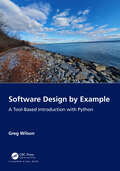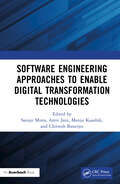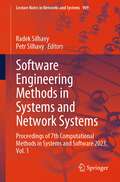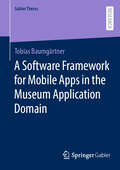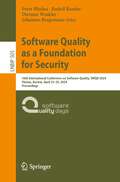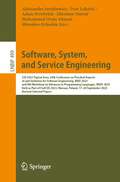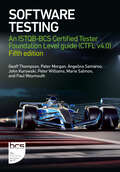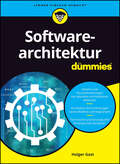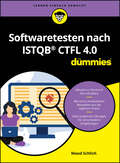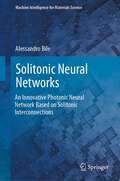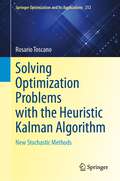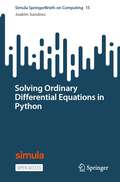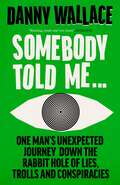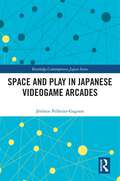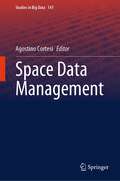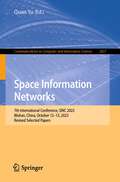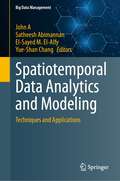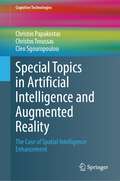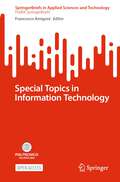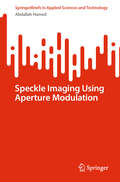- Table View
- List View
Software Design by Example: A Tool-Based Introduction with Python
by Greg WilsonThe best way to learn design in any field is to study examples, and some of the best examples of software design come from the tools programmers use in their own work. Software Design by Example: A Tool-Based Introduction with Python therefore builds small versions of the things programmers use in order to demystify them and give some insights into how experienced programmers think. From a file backup system and a testing framework to a regular expression matcher, a browser layout engine, and a very small compiler, we explore common design patterns, show how making code easier to test also makes it easier to reuse, and help readers understand how debuggers, profilers, package managers, and version control systems work so that they can use them more effectively.This material can be used for self-paced study, in an undergraduate course on software design, or as the core of an intensive weeklong workshop for working programmers. Each chapter has a set of exercises ranging in size and difficulty from half a dozen lines to a full day’s work. Readers should be familiar with the basics of modern Python, but the more advanced features of the language are explained and illustrated as they are introduced.All the written material in this project can be freely reused under the terms of the Creative Commons - Attribution license, while all of the software is made available under the terms of the Hippocratic License. All proceeds from sale of this book will go to support the Red Door Family Shelter in Toronto.Features:• Teaches software design by showing programmers how to build the tools they useevery day• Each chapter includes exercises to help readers check and deepen their understanding• All the example code can be downloaded, re-used, and modified under an open license
The Software Developer's Guide to Linux: A practical, no-nonsense guide to using the Linux command line and utilities as a software developer
by David Cohen Christian SturmA must-read for software developers lacking command-line skills, focusing on Linux. It provides transferable command-line proficiency for use in Mac OS, Unix, and Windows with WSLKey FeaturesA practical, no-nonsense guide specifically written for developers (not sysadmins) who need to quickly learn command-line skillsExpand your practical skills and look like a wizard on the command lineBuild practical skills to work effectively with the most common CLI tools on Unix-like systemsBook DescriptionDevelopers are always looking to raise their game to the next level, yet most are completely lost when it comes to the Linux command line. This book is the bridge that will take you to the next level in your software development career. Most of the skills in the book can be immediately put to work to make you a more efficient developer. It’s written specifically for software engineers, not Linux system administrators, so each chapter will equip you with just enough theory to understand what you’re doing before diving into practical commands that you can use in your day-to-day work as a software developer. As you work through the book, you’ll quickly absorb the basics of how Linux works while you get comfortable moving around the command line. Once you’ve got the core skills, you’ll see how to apply them in different contexts that you’ll come across as a software developer: building and working with Docker images, automating boring build tasks with shell scripts, and troubleshooting issues in production environments. By the end of the book, you’ll be able to use Linux and the command line comfortably and apply your newfound skills in your day-to-day work to save time, troubleshoot issues, and be the command-line wizard that your team turns to.What you will learnLearn useful command-line tricks and tools that make software development, testing, and troubleshooting easyUnderstand how Linux and command line environments actually workCreate powerful, customized tools and save thousands of lines of code with developer-centric Linux utilitiesGain hands-on experience with Docker, SSH, and Shell scripting tasks that make you a more effective developerGet comfortable searching logs and troubleshooting problems on Linux serversHandle common command-line situations that stump other developersWho this book is forThis book is for software developers who want to build practical Command-Line (CLI) and Linux skills and who want to quickly fill the gap to advance their skills and their career. Basic knowledge of editing text, working with files and folders, having some idea of what “operating systems” are, installing software, and using a development environment is assumed.
Software Engineering Approaches to Enable Digital Transformation Technologies
Software Engineering Approaches to Enable Digital Transformation Technologies features contributions reflecting ideas and research in enabling digital transformation technologies through software engineering. To date, multiple, different approaches have been adopted to develop software solutions for a variety of different problems. Of all the available approaches, the main approaches are level-oriented, data flow-oriented, data structure-oriented, and object-oriented design approaches. The other focus of the book is digital transformation, which can be defined as the adoption of digital technology to improve efficiency, value, and innovation Digitalization is more than just putting additional technological systems and services in place. Rather than improving conventional methods, a true digital transformation initiative includes radically rethinking company structures and procedures. There are four types of digital transformation: business process, business model, domain, and cultural and organizational. Companies are being challenged to develop new business models that consider and harness digitalization. From the standpoint of software engineering, digital transformation alters how software is built. Current trends include the development of mobile applications, cloud applications, and Internet of Things (IoT) applications. Emerging trends are the development of digital twins, robotics, artificial intelligence, machine learning, augmented reality, and additive manufacturing. This book examines the challenges that arise due to digitization in society and presents plausible solutions that could be applied to counter these challenges and convert them into opportunities. These solutions may further be improvised and worked out for the software companies from the technological perspective, organizational perspective, and management perspective.
Software Engineering Approaches to Enable Digital Transformation Technologies
by Sanjay Misra Amit Jain Manju Kaushik Chitresh BanerjeeSoftware Engineering Approaches to Enable Digital Transformation Technologies features contributions reflecting ideas and research in enabling digital transformation technologies through software engineering. To date, multiple, different approaches have been adopted to develop software solutions for a variety of different problems. Of all the available approaches, the main approaches are level-oriented, data flow-oriented, data structure-oriented, and object-oriented design approaches. The other focus of the book is digital transformation, which can be defined as the adoption of digital technology to improve efficiency, value, and innovation Digitalization is more than just putting additional technological systems and services in place. Rather than improving conventional methods, a true digital transformation initiative includes radically rethinking company structures and procedures. There are four types of digital transformation: business process, business model, domain, and cultural and organizational. Companies are being challenged to develop new business models that consider and harness digitalization. From the standpoint of software engineering, digital transformation alters how software is built. Current trends include the development of mobile applications, cloud applications, and Internet of Things (IoT) applications. Emerging trends are the development of digital twins, robotics, artificial intelligence, machine learning, augmented reality, and additive manufacturing. This book examines the challenges that arise due to digitization in society and presents plausible solutions that could be applied to counter these challenges and convert them into opportunities. These solutions may further be improvised and worked out for the software companies from the technological perspective, organizational perspective, and management perspective.
Software Engineering Methods in Systems and Network Systems: Proceedings of 7th Computational Methods in Systems and Software 2023, Vol. 1 (Lecture Notes in Networks and Systems #909)
by Radek Silhavy Petr SilhavyThis book presents cutting-edge research and methodologies in software engineering, specifically focusing on systems and network systems. It showcases novel development approaches and network system optimizations, highlighting the field's dynamic evolution. The book is designed for experts, scholars, and professionals, offering insights and tools crucial for advancing the software engineering landscape. Its diverse content makes it an invaluable resource for seasoned professionals and those new to the field, inspiring and enriching readers' understanding of software engineering's future directions.
A Software Framework for Mobile Apps in the Museum Application Domain (Gabler Theses)
by Tobias BaumgärtnerThis book is concerned with “How to provide guidance for small cultural heritage institutions to govern digital transformation, and how to align the possibilities with the available capabilities by creating a Software Framework for Mobile Apps in the Museum Application Domain?”. The role of the museum has shifted from a keeper of artifacts to a provider of information. In this context mobile applications are intended to generate added value for the museum visitor. However, the tension between the application’s creator, its content, and the consumer operating the app needs to be examined holistically. As it is not trivial to create an integrated user experience, the unique usability-centered perspective on the requirements engineering pursued throughout, allows for the suggested data-driven solution to address the specific domain issues and serve the intended audience. Based on the insights gained during this examination and under the utilization of design science research, human-centered design, and domain-driven design “A Software Framework for Mobile Apps in the Museum Application Domain” is created and implemented using web technologies.
Software Quality as a Foundation for Security: 16th International Conference on Software Quality, SWQD 2024, Vienna, Austria, April 23–25, 2024, Proceedings (Lecture Notes in Business Information Processing #505)
by Peter Bludau Rudolf Ramler Dietmar Winkler Johannes BergsmannThis book constitutes the refereed proceedings of the 16th Software Quality Days Conference, SWQD 2024, held in Vienna, Austria, during April 23-25, 2024. The Software Quality Days (SWQD) conference started in 2009 and has grown to the biggest conference on software quality in Europe. The program of the SWQD conference is designed to encompass a stimulating mixture of practical presentations and new research topics in scientific presentations. The guiding conference topic of the SWQD 2024 is “Software Quality as a Foundation for Security”. The 7 full papers and 2 short papers presented in this volume were carefully reviewed and selected from 16 submissions. The papers were organized in topical sections as follows: Requirements engineering; software quality; continuous integration and deployment; communication and collaboration; artificial intelligence; and security and compliance.
Software, System, and Service Engineering: S3E 2023 Topical Area, 24th Conference on Practical Aspects of and Solutions for Software Engineering, KKIO 2023, and 8th Workshop on Advances in Programming Languages, WAPL 2023, Held as Part of FedCSIS 2023, Warsaw, Poland, 17–20 September 2023, Revised Selected Papers (Lecture Notes in Business Information Processing #499)
by Aleksander Jarzębowicz Ivan Luković Adam Przybyłek Mirosław Staroń Muhammad Ovais Ahmad Mirosław OchodekThis book constitutes the refereed proceedings of the S3E 2023 Topical Area, 24th Conference on Practical Aspects of and Solutions for Software Engineering, KKIO 2023, and 8th Workshop on Advances in Programming Languages, WAPL 2023, as Part of FedCSIS 2023, held in Warsaw, Poland, during September 17–20, 2023. The 6 revised papers presented in this book were carefully reviewed and selected from a total of 55 submissions. They focus on new ideas and developments in practical aspects and solutions for software engineering.
Software Testing: An ISTQB-BCS Certified Tester Foundation Level guide (CTFL v4.0) - Fifth edition
by Geoff Thompson Peter Morgan Angelina Samaroo John Kurowski Peter Williams Marie SalmonThis bestselling study guide explains the basic steps of software testing and how to perform effective tests in both traditional and Agile environments. It provides an overview of all key techniques, including dynamic and static, and guidance on exam preparation for the ISTQB Certified Tester Foundation Level exam (current to v4.0) This is the official BCS and UKITB textbook , and includes self-assessment exercises, guidance notes on the syllabus topics, plus examples and exercises reflecting current technology and applications, as well as example questions aligned to the syllabus. This brand new fifth edition is ideal for those with a little experience of software testing who wish to cement their knowledge with industry-recognised techniques and theory and those who wish to undertake the ISTQB CTFL v4.0 certification. The book that covers the new ISTQB Certified Tester Foundation Level version 4.0 Syllabus, that includes both traditional and Agile testing principals. The official BCS and UKITB textbook for the ISTQB Certified Tester Foundation Level version 4.0 certificate, that supports the training provider courses and the ISTQB exam. Updated with syllabus version 4.0 content, standards and example questions. Written by those involved in the syllabus development.
Software Testing: An ISTQB-BCS Certified Tester Foundation Level guide (CTFL v4.0) - Fifth edition
by Geoff Thompson Peter Morgan Angelina Samaroo John Kurowski Peter Williams Marie SalmonThis bestselling study guide explains the basic steps of software testing and how to perform effective tests in both traditional and Agile environments. It provides an overview of all key techniques, including dynamic and static, and guidance on exam preparation for the ISTQB Certified Tester Foundation Level exam (current to v4.0) This is the official BCS and UKITB textbook , and includes self-assessment exercises, guidance notes on the syllabus topics, plus examples and exercises reflecting current technology and applications, as well as example questions aligned to the syllabus. This brand new fifth edition is ideal for those with a little experience of software testing who wish to cement their knowledge with industry-recognised techniques and theory and those who wish to undertake the ISTQB CTFL v4.0 certification. The book that covers the new ISTQB Certified Tester Foundation Level version 4.0 Syllabus, that includes both traditional and Agile testing principals. The official BCS and UKITB textbook for the ISTQB Certified Tester Foundation Level version 4.0 certificate, that supports the training provider courses and the ISTQB exam. Updated with syllabus version 4.0 content, standards and example questions. Written by those involved in the syllabus development.
Softwarearchitektur für Dummies (Für Dummies)
by Holger GastTragfähige Literatur für Ihre Softwarearchitekturen Besuchen Sie eine Veranstaltung zu Softwarearchitektur oder stehen Sie in einem Projekt vor Architekturentscheidungen und wollen daher die aktuellen Architekturansätze verstehen? Dann hilft Ihnen dieses Buch. Holger Gast erläutert zunächst die grundlegenden Elemente von Architekturen und führt die technischen Hintergründe aus. Er erklärt Ihnen danach die klassischen Stile und Patterns und geht schließlich auf Cloud-Architekturen ein. Durchgängig legt er den Fokus auf konkrete Softwarestrukturen statt auf Theorie und ermöglicht Ihnen so einen verständlichen und zügigen Einstieg in das Thema. Sie erfahren Wie Sie Entscheidungen zum Aufbau einer Anwendung treffen Wann bestimmte Architekturen oder Frameworks für Ihr Projekt geeignet sind Welche Herausforderungen Sie bei der Erstellung oder Weiterentwicklung einer Anwendung lösen müssen
Softwaretesten nach ISTQB CTFL 4.0 für Dummies (Für Dummies)
by Maud SchlichNeue Hauptversion 4.0: Neuer Lehrplan, geänderter Prüfungsumfang! Soll in Ihrem Unternehmen neue Software eingeführt werden und Sie müssen sie testen? Oder wollen Sie als Entwickler über den Tellerrand schauen und sich auch mit dem Softwaretesten beschäftigen? Leicht verständlich erläutert Ihnen Maud Schlich alle vom ISTQB® Certified Tester Foundation Level geforderten Lerninhalte sowohl für Programmierer als auch mit Blick auf Fachanwender, die die Software später einsetzen. Zahlreiche praxisorientierte Beispiele und übungen sorgen für eine optimale Prüfungsvorbereitung. Darüber hinaus erfahren Sie für alle Testaktivitäten, wie sie jeweils im klassischen oder im agilen Kontext geplant und durchgeführt werden. Sie erfahren Aus welchen Aktivitäten der Testprozess besteht Wie Sie unterschiedliche Testverfahren nutzen Wie Entwickler und Tester optimal zusammenarbeiten Wie Sie prüfen, ob Sie noch im Plan sind
Solitonic Neural Networks: An Innovative Photonic Neural Network Based on Solitonic Interconnections (Machine Intelligence for Materials Science)
by Alessandro BileThis book delves into optics and photonic materials, describing the development of an intelligent all-optical system capable of replicating the functional building blocks of the biological brain. Starting with an analysis of biological neuronal dynamics and traversing the state of the art of neuromorphic systems developed to date, the book arrives at a description of neural networks realized through spatial soliton technology.After a brief introduction to the biology of neural networks (Chapter 1), the book delves into the description of the neuromorphic problem emphasizing the peculiarities of optical hardware developed to date. (Chapter 2). Chapter 3 is dedicated to the description of psychomemories , which represent the modeling of human learning according to the theories of modern neuro-psychology. This chapter provides the prerequisites for understanding how solitonic neural networks (SNNs) are able to learn and how they approach biological models. Chapter 4 focuses on the experimentation of solitonic optic neurons in thin layers of lithium niobate. Optical techniques for supervised and unsupervised learning are discussed. The entire chapter is accompanied by theoretical, simulative and experimental results. This chapter explains how an X-junction neuron is able to establish synapses, modify them, or erase them. The erasure of solitonic structures represents an important innovation in the field of nonlinear optics. Finally, Chapter 5 reports on the implementation of a network of neurons capable of processing information and storing it exactly as a human episodic memory does. The chapter ends with a number of insights into the lines of research that are currently being pursued on the basis of the results obtained.The book is meant for graduate students and researchers in the fields of optics, photonic applications, and biology. However, the main beneficiaries of this book are senior researchers in the field of nonlinear optics and artificial intelligence. To fully understand the results, it is important to have a basic knowledge of optical physics and neuron biology.
Solutions Architect's Handbook: Kick-start your career with architecture design principles, strategies, and generative AI techniques
by Saurabh Shrivastava Neelanjali SrivastavFrom fundamentals and design patterns to the latest techniques such as generative AI, machine learning and cloud native architecture, gain all you need to be a pro Solutions Architect crafting secure and reliable AWS architecture.Key FeaturesHits all the key areas -Rajesh Sheth, VP, Elastic Block Store, AWSOffers the knowledge you need to succeed in the evolving landscape of tech architecture - Luis Lopez Soria, Senior Specialist Solutions Architect, GoogleA valuable resource for enterprise strategists looking to build resilient applications - Cher Simon, Principal Solutions Architect, AWSBook DescriptionMaster the art of solution architecture and excel as a Solutions Architect with the Solutions Architect's Handbook. Authored by seasoned AWS technology leaders Saurabh Shrivastav and Neelanjali Srivastav, this book goes beyond traditional certification guides, offering in-depth insights and advanced techniques to meet the specific needs and challenges of solutions architects today. This edition introduces exciting new features that keep you at the forefront of this evolving field. Large language models, generative AI, and innovations in deep learning are cutting-edge advancements shaping the future of technology. Topics such as cloud-native architecture, data engineering architecture, cloud optimization, mainframe modernization, and building cost-efficient and secure architectures remain important in today's landscape. This book provides coverage of these emerging and key technologies and walks you through solution architecture design from key principles, providing you with the knowledge you need to succeed as a Solutions Architect. It will also level up your soft skills, providing career-accelerating techniques to help you get ahead. Unlock the potential of cutting-edge technologies, gain practical insights from real-world scenarios, and enhance your solution architecture skills with the Solutions Architect's Handbook.What you will learnExplore various roles of a solutions architect in the enterpriseApply design principles for high-performance, cost-effective solutionsChoose the best strategies to secure your architectures and boost availabilityDevelop a DevOps and CloudOps mindset for collaboration, operational efficiency, and streamlined productionApply machine learning, data engineering, LLMs, and generative AI for improved security and performanceModernize legacy systems into cloud-native architectures with proven real-world strategiesMaster key solutions architect soft skillsWho this book is forThis book is for software developers, system engineers, DevOps engineers, architects, and team leaders who already work in the IT industry and aspire to become solutions architect professionals. Solutions architects who want to expand their skillset or get a better understanding of new technologies will also learn valuable new skills. To get started, you'll need a good understanding of the real-world software development process and some awareness of cloud technology.
Solving Optimization Problems with the Heuristic Kalman Algorithm: New Stochastic Methods (Springer Optimization and Its Applications #212)
by Rosario ToscanoThis text focuses on simple and easy-to-use design strategies for solving complex engineering problems that arise in several fields of engineering design, namely non-convex optimization problems. The main optimization tool used in this book to tackle the problem of nonconvexity is the Heuristic Kalman Algorithm (HKA). The main characteristic of HKA is the use of a stochastic search mechanism to solve a given optimization problem. From a computational point of view, the use of a stochastic search procedure appears essential for dealing with non-convex problems.The topics discussed in this monograph include basic definitions and concepts from the classical optimization theory, the notion of the acceptable solution, machine learning, the concept of preventive maintenance, and more. The Heuristic Kalman Algorithm discussed in this book applies to many fields such as robust structured control, electrical engineering, mechanical engineering, machine learning, reliability, and preference models. This large coverage of practical optimization problems makes this text very useful to those working on and researching systems design. The intended audience includes industrial engineers, postgraduates, and final-year undergraduates in various fields of systems design.
Solving Ordinary Differential Equations in Python (Simula SpringerBriefs on Computing #15)
by Joakim SundnesThis open access volume explains the foundations of modern solvers for ordinary differential equations (ODEs). Formulating and solving ODEs is an essential part of mathematical modeling and computational science, and numerous solvers are available in commercial and open source software. However, no single ODE solver is the best choice for every single problem, and choosing the right solver requires fundamental insight into how the solvers work. This book will provide exactly that insight, to enable students and researchers to select the right solver for any ODE problem of interest, or implement their own solvers if needed. The presentation is compact and accessible, and focuses on the large and widely used class of solvers known as Runge-Kutta methods. Explicit and implicit methods are motivated and explained, as well as methods for error control and automatic time step selection, and all the solvers are implemented as a class hierarchy in Python.
Somebody Told Me: One Man’s Unexpected Journey Down the Rabbit Hole of Lies, Trolls and Conspiracies
by Danny Wallace'Shocking, timely and - as you’d expect from Danny Wallace - very funny' - Adam Kay'Thrilling, thought-provoking, funny and wise. Danny has an incredible knack for taking the bizarre fringes and rabbit holes of humanity and making them compulsively laugh-out-loud readable.' - Danny Robins, journalist, presenter of Uncanny and writer of 2:22 A Ghost Story'Danny Wallace lightens this dark topic about lies and propaganda with his trademark humour and gets the balance just right' – BBC, Books to Read in 2024Have you been keeping your eye on your grandma lately? Have you been calling her enough? You sure she’s not spending too much time on YouTube? Is she talking fondly of dictators? Has she suddenly started quietly muttering in the Aldi queue about the “Jewish Space Lasers” she’s heard are setting wildfires around the world to make sure everyone believes in climate change? When was the moment the world began to believe anything?Danny Wallace, million-copy bestselling author of Yes Man and Join Me, has fallen down the modern rabbit hole of lies, conspiracies and disinformation. Along the way, he encounters families torn apart by accusations and fake news, journalists putting themselves on the frontline of the disinformation war, reformed conspiracy theorists, influencers who see profit in stoking paranoia, and the shadowy nameless, faceless trolls on the other side of our screens. He discovers how disinformation and well-told lies can ruin a year or a whole life, how they can affect our family, our street, our community. How they can spread across a country, a continent, even the world. How they take hold of our imaginations and make us feel both helpless and powerful.And Danny asks: can you do anything to stop it – even with the truth on your side?
Space and Play in Japanese Videogame Arcades (Routledge Contemporary Japan Series)
by Jérémie Pelletier-GagnonThis book presents a scholarly investigation of the development and culture of Japanese videogame arcades, both from a historical and contemporary point of view.Providing an overview of the historical evolution of public amusement spaces from the early rooftop amusement spaces from the early nineteenth century to the modern multi‑floor and interconnected arcade complexes that characterize the urban fabric of contemporary Japan, the book argues that arcade videogames and their associated practices must be examined in the context in which they are played, situated in the interrelation between the game software, the cabinets as material conditions of play, and the space of the venue that frames the experience. Including three case studies of distinct and significant game centres located in Tokyo and Kyoto, the book addresses of play in public, including the notion of performance and observation as play practices, spatial appropriation, as well as the compartmentalization of the play experience.In treating videogames as sets of circumstances, the book identifies the opportunities for ludic practices that videogame arcades provide in Japan. As such, it will appeal to students and scholars of Game Studies and Digital Media Studies, as well as those of Japanese Culture and Society.
Space and Play in Japanese Videogame Arcades (Routledge Contemporary Japan Series)
by Jérémie Pelletier-GagnonThis book presents a scholarly investigation of the development and culture of Japanese videogame arcades, both from a historical and contemporary point of view.Providing an overview of the historical evolution of public amusement spaces from the early rooftop amusement spaces from the early nineteenth century to the modern multi‑floor and interconnected arcade complexes that characterize the urban fabric of contemporary Japan, the book argues that arcade videogames and their associated practices must be examined in the context in which they are played, situated in the interrelation between the game software, the cabinets as material conditions of play, and the space of the venue that frames the experience. Including three case studies of distinct and significant game centres located in Tokyo and Kyoto, the book addresses of play in public, including the notion of performance and observation as play practices, spatial appropriation, as well as the compartmentalization of the play experience.In treating videogames as sets of circumstances, the book identifies the opportunities for ludic practices that videogame arcades provide in Japan. As such, it will appeal to students and scholars of Game Studies and Digital Media Studies, as well as those of Japanese Culture and Society.
Space Data Management (Studies in Big Data #141)
by Agostino CortesiThe book presents latest results pertaining to challenges faced by researchers in space data management. There are large number of highly important applications that currently rely upon data from satellites and space missions, ranging from weather prediction to monitoring of environmental pollution, climate change, marine traffic, agriculture, and urban planning, etc. The quality and quantity of space data poses new and specific challenges to the scientific community, covering the entire life cycle of space data management and with a need for an interdisciplinary approach. The chapters written by experts discusses impacts of these challenges, and report activities that can stimulate new research.
Space Information Networks: 7th International Conference, SINC 2023, Wuhan, China, October 12–13, 2023, Revised Selected Papers (Communications in Computer and Information Science #2057)
by Quan YuThis book constitutes revised selected papers from the thoroughly refereed proceedings of the 7th International Conference on Space Information Network, SINC 2023, held in Wuhan, China, during October 12–13, 2023. The 8 full papers and 5 short papers included in this book were carefully reviewed and selected from 73 submissions. The papers present the latest research in the fields of space information networks.
Spatiotemporal Data Analytics and Modeling: Techniques and Applications (Big Data Management)
by John A Satheesh Abimannan El-Sayed M. El-Alfy Yue-Shan ChangWith the growing advances in technology and transformation to digital services, the world is becoming more connected and more complex. Huge heterogeneous data are generated at rapid speed from various types of sensors. Augmented with artificial intelligence and machine learning and internet of things, latent relations, and new insights can be captured helping in optimizing plans and resource utilization, improving infrastructure, and enhancing quality of services. A “spatial data management system” is a way to take care of data that has something to do with space. This could include data such as maps, satellite images, and GPS data. A temporal data management system is a system designed to manage data that has a temporal component. This could include data such as weather data, financial data, and social media data. Some advanced techniques used in spatial and temporal data management systems include geospatial indexing for efficient querying and retrieval of location-based data, time-series analysis for understanding and predicting temporal patterns in datasets like weather or financial trends, machine learning algorithms for uncovering hidden patterns and correlations in large and complex datasets, and integration with Internet of Things (IoT) technologies for real-time data collection and analysis. These techniques, augmented with artificial intelligence, enable the extraction of latent relations and insights, thereby optimizing plans, improving infrastructure, and enhancing the quality of services. This book provides essential technical knowledge, best practices, and case studies on the state-of-the-art techniques of artificial intelligence and machine learning for spatiotemporal data analysis and modeling. The book is composed of several chapters written by experts in their fields and focusing on several applications including recommendation systems, big data analytics, supply chains and e-commerce, energy consumption and demand forecasting,and traffic and environmental monitoring. It can be used as academic reference at graduate level or by professionals in science and engineering related fields such as data science and engineering, big data analytics and mining, artificial intelligence, machine learning and deep learning, cloud computing, and internet of things.
Special Topics in Artificial Intelligence and Augmented Reality: The Case of Spatial Intelligence Enhancement (Cognitive Technologies)
by Christos Papakostas Christos Troussas Cleo SgouropoulouThis monograph explores the synergy of Artificial Intelligence (AI), Augmented Reality (AR) and cognitive processes to enhance spatial abilities — an integral aspect of cognitive development. The ability to comprehend and manipulate spatial information is not only fundamental to our understanding of the physical world but also plays a pivotal role in numerous academic and professional fields. Recognizing the profound impact of spatial ability on scientific disciplines and educational achievement, this monograph takes on the challenge of enhancing spatial skills among users.The authors present the design and development of a mobile training system that incorporates AR features to enhance learners’ spatial ability. Involving mental generation, transformation, and rotation of visual images for understanding spatial relationships, spatial ability is closely linked to success in various scientific disciplines and educational pursuits. While spatial visualization skills tests are available, this monograph takes a unique approach by focusing on developing targeted interventions to improve spatial ability. It aims to unlock new avenues for cognitive growth and dive into the untapped potential within the realm of spatial intelligence. Beyond its emphasis on spatial ability enhancement, this monograph goes above and beyond traditional approaches by integrating AI techniques into the training system. As such, it aims to provide personalized and adaptive learning experiences for learners. The training system, through intelligent techniques, dynamically analyzes individual learners’ strengths, weaknesses, and progress, tailoring content and challenges to their specific needs. This effort establishes a new frontier in educational technology, offering a groundbreaking solution that not only augments spatial ability development but also showcases the transformative potential of AI in reshaping the learning experience.The book is a valuable resource for researchers, educators, developers and technology enthusiasts, as it exemplifies the profound impact of AI and AR in shaping the future of online learning experiences.
Special Topics in Information Technology (SpringerBriefs in Applied Sciences and Technology)
by Francesco AmigoniThis open access book presents outstanding doctoral dissertations in Information Technology from the Department of Electronics, Information and Bioengineering, Politecnico di Milano, Italy. Information Technology has always been highly interdisciplinary, as many aspects have to be considered in IT systems. The doctoral studies program in IT at Politecnico di Milano emphasizes this interdisciplinary nature, which is becoming more and more important in recent technological advances, in collaborative projects, and in the education of young researchers. Accordingly, the focus of advanced research is on pursuing a rigorous approach to specific research topics starting from a broad background in various areas of Information Technology, especially Computer Science and Engineering, Electronics, Systems and Control, and Telecommunications. Each year, more than 50 Ph.D.s. graduate from the program. This book gathers the outcomes of the best theses defended in 2022–23 and selected for the IT Ph.D. Award. Each of the authors provides a chapter summarizing his/her findings, including an introduction, description of methods, main achievements and future work on the topic. Hence, the book provides a cutting-edge overview of the latest research trends in Information Technology at Politecnico di Milano, presented in an easy-to-read format that will also appeal to non-specialists.
Speckle Imaging Using Aperture Modulation (SpringerBriefs in Applied Sciences and Technology)
by Abdallah HamedThis book covers speckle image formation using a variety of modulated apertures. The central theme revolves around theoretical analyses, specifically the calculation of impulse responses or Point Spread Functions (PSFs) corresponding to these apertures. These calculations provide crucial insights into the resolution inherent in the resulting speckle images. The book begins with an examination of the recognition of the direction of new apertures from elongated speckle images, setting the stage for subsequent discussions. The theoretical analyses extend to diverse aperture designs, including Gaussian, graded-index, and modulated apertures. The book delves into the nuanced dynamics of contrast in speckle images, exploring the Voigt distribution and the effects of modulation on contrast. In addition to aperture-centric discussions, the book addresses the processing of the formed speckle images. The chapters impart a comprehensive understanding of speckle imaging, encompassing discrimination in microscopy using digital speckle images, the utilization of concentric hexagonal pupils, and the exploration of irregular apertures. The book culminates in a detailed exploration of speckle imaging in the context of an annular Hermite Gaussian laser beam. Overall, this book serves as a valuable resource for researchers and academics seeking a profound exploration of speckle image formation, modulation, and processing across a spectrum of apertures and theoretical frameworks.
